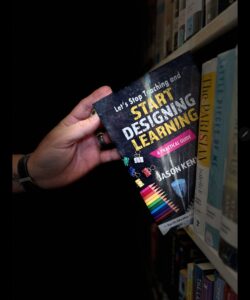Tasks must be designed, not just assigned. This is a key difference in the mindset of a teacher versus a learning engineer. If we want learning to happen, we have to design our tasks accordingly. Last time, we discussed how these tasks we ask our learners to produce must SHOW that learning took place. In addition to that, we have to provide a success criteria for our learners to use in order to monitor just where they are in their learning and how their task products reflect that.
So, where does teaching come into the design process? I am so glad you asked. Previously, we discussed the four qualities of a well-designed learning task. The third and fourth qualities are listed here:
- Prepared for by Instruction
- Provide Escapes from Misunderstanding and Opportunities to Accelerate
The third quality of Instruction is where the teaching takes place, and it can be summed up in this acronym: In well-designed instruction, teachers provide the G.I.S.T. (Guided Information, Skills and Tools) needed for the students to complete the task for learning. Quitting teaching does not mean we quit instruction. It is simply a mindset change. The G.I.S.T. allows us as learning engineers to take a step back and look at what we are asking as the result of learning and come up with what we in turn must supply our learners with in order for them to be successful. This is the vital role of you being the facilitator of learning in the room. Let’s look at the G.I.S.T.
First word, Guided. This means you are the lead. You, the teacher, lead and guide students through the upcoming information and processes. Without you, our learners are just thrown things to work on without clear guidance. Next, Information. What are the facts, numbers, formulas, texts and other tangible data you must guide your learners through in order for them to take it and use on the task to show learning? Skills… What actions and processes will you need to guide learners through so they can submit their learning to you? Do you need to model annotation, working out a linear equation, thinking aloud during your reading? What actions do your learners need to be modeled to put into practice? And finally, Tools. What will you provide for the learners who get “stuck?” Where can learners turn, before running to the teacher, in order to escape their own misunderstanding and learn to move forward as owners of their own learning? On the other hand, where can learners who master the task at hand go to to find ways to take their learning further and deeper on the task? The G.I.S.T. has to be anticipated for, designed for and planned for implementation in your classroom in order for learners to take ownership in their learning and move themselves forward. This way, the majority of your class can, with little assistance on the teacher’s part, take charge of their learning and manage themselves. This leaves the teacher with the time and opportunity to take the small group of struggling learners and work more intensely to remediate.
This leads us into the fourth quality of learning tasks which include providing escapes from misunderstanding and opportunities to accelerate. These were both mentioned above as the Tools in the G.I.S.T. we as teachers should be guiding our students through. In an earlier post, I shared a guiding document that can assist in the development of success criteria. The document HERE can also be utilized to create the tools for our learners who need assistance in moving up in their learning. Looking at what poor student work looks like for a task, teachers can foresee common areas of misunderstanding and design tools for learners to use, along with the success criteria, in order to take charge of their own learning, figure things out, and basically learn. These tools can vary widely. Sentence stems, flow charts, guiding questions, labeled examples and countless other tools can be designed and made available for learners to turn to first before raising a hand for the teacher.
By giving your time and energy upfront in designing, you will get all of the time and energy back while teaching in the classroom. With the qualities we’ve discussed, your classroom of 30 can be reduced to a small remedial group of 5 to 6 while the rest of your learners are prepared by you to take on the learning task with the tools you have provided. You will now be the one leaving with all the energy at the end of the day while your learners will be tired because you have turned the learning and the work over to the ones they belong to: the learners in your room. This is the beauty of designing learning. It frees learners to learn and teachers to focus their attention to those learners needing extra guidance. Design and facilitate instead of plan and teach. It is better for everyone!


